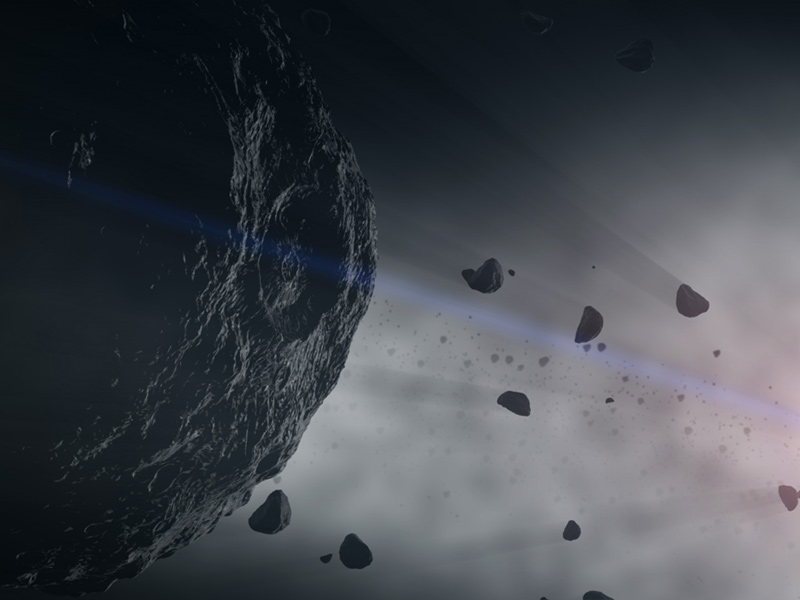Cyanide-Laced Meteorites May Have Seeded Earth's First Life

Cyanide isn't just the last resort for the captured spies of Hollywood film. It's also a crucial component of the early chemistry of life. And now, new research finds that cyanide might have ridden to Earth on meteorites.
Samples of a particular group of primitive meteorites — including a large one that fell near Murchison, Australia, in 1969 — all contain cyanide, bound in a stable configuration with iron and carbon monoxide. These same sorts of structures are found in enzymes called hydrogenases in modern bacteria and archaea, which could suggest that early life either borrowed from meteorites or that early Earth's geology formed the same kind of cyanide compounds, said study co-author Michael Callahan, an analytical chemist Boise State University. [Crash! 10 Biggest Impact Craters on Earth]
"When you study these primitive meteorites it's like you're hopping into a time machine and you can go back and study these ancient materials," Callahan told Live Science. "And then you find these connections to life and ancient biology."
Seeking cyanide
Callahan and his colleagues began seeking cyanide in space rocks after publishing a 2011 paper in which they discovered nucleobases in meteorites. Nucleobases, like guanine or adenine, are among the building blocks of DNA. The chemistry of the nucleobases and their parent asteroids looked as though it depended on cyanide as a reactant, Callahan said. But he wasn't confident that they'd be able to find any cyanide on meteorites, even if it had once existed. Cyanide is extremely reactive, Callahan said, so he expected that it would have been used up and transformed long before it landed on Earth.
But study co-author Karen Smith, also a Boise State analytical chemist, had a background in cyanide analysis, so the researchers gathered and tested samples of meteorites, most of which had been discovered in Antarctica. Five of the meteorites were a particular kind of carbonaceous chondrite called CM chondrites, which contain nucleobases as well as other building blocks of biology, such as amino acids. One of those CM chondrites was the Murchison meteorite, which landed in Australia in 1969, stunning locals with a large fireball.
To find and extract cyanide, the researchers borrowed techniques that typically used to find the toxic stuff in wastewater left over from industrial processes, Callahan said. They used acid to extract compounds from the meteorites and then subjected it to a battery of analyses, including mass spectrometry and liquid chromatography, both of which allowed them to identify the constituent parts of the extracted material.
Cyanide surprises
To their surprise, the researchers found cyanide. Each of the CM chondrites contained the chemical, while none of the other types of meteorites did. (The researchers even tested a famous Mars meteorite that was once claimed to hold evidence of alien life — no cyanide there.)
Sign up for the Live Science daily newsletter now
Get the world’s most fascinating discoveries delivered straight to your inbox.
The cyanide seems to have survived billions of years in space and a fiery trip to rest in icy Antarctica because it was bound up in a stable configuration with carbon monoxide and iron. "It's this really classical inorganic chemistry," Callahan said.
However stable it is, the cyanide can also be released from the meteorite, Callahan added, and that makes it an intriguing possible player in the origin of life. A combination of water and ultraviolet light could have released cyanide from meteorites on the early Earth, when bombardment by space rocks was common. In that way, meteorites could have boosted the available cyanide for chemical reactions that led, eventually, to living cells, Callahan said.

Alternatively, early Earth's cyanide could have been home-grown, Callahan said. But if so, it might have formed in very similar ways as it does on meteorites. Meteorites are made of the same space dust and ice that formed the planets, but they haven't been altered by geochemical processes.
The other intriguing surprise, Callahan said, was the strange similarities between the meteorite's bundles of carbon monoxide, iron and cyanide and parts of the enzymes of some of the oldest groups of life, archaea and bacteria. All bacteria and archaea have enzymes called hydrogenases, Callahan said, and the active site of those enzymes, where the bonding happens, is the same as the cyanide structures seen in the meteorites.
"Maybe these [meteorite compounds] are the precursors of these active sites," Callahan said.
That's not yet proven, Callahan said, but the research team plans further work on meteorite chemistry. One future direction could come courtesy of the ongoing NASA mission OSIRIS-Rex, which will collect a sample from the asteroid Bennu and deliver it to Earth in 2023. Bennu might be a CM chondrite, Callahan said, which would provide an exciting opportunity to study a pristine sample of an asteroid parent body.
Callahan and his colleagues reported their work June 25 in the open-access journal Nature Communications.
- When Space Attacks: The 6 Craziest Meteor Impacts
- In Images: The Oldest Fossils on Earth
- 7 Theories on the Origin of Life
Originally published on Live Science.

Stephanie Pappas is a contributing writer for Live Science, covering topics ranging from geoscience to archaeology to the human brain and behavior. She was previously a senior writer for Live Science but is now a freelancer based in Denver, Colorado, and regularly contributes to Scientific American and The Monitor, the monthly magazine of the American Psychological Association. Stephanie received a bachelor's degree in psychology from the University of South Carolina and a graduate certificate in science communication from the University of California, Santa Cruz.










